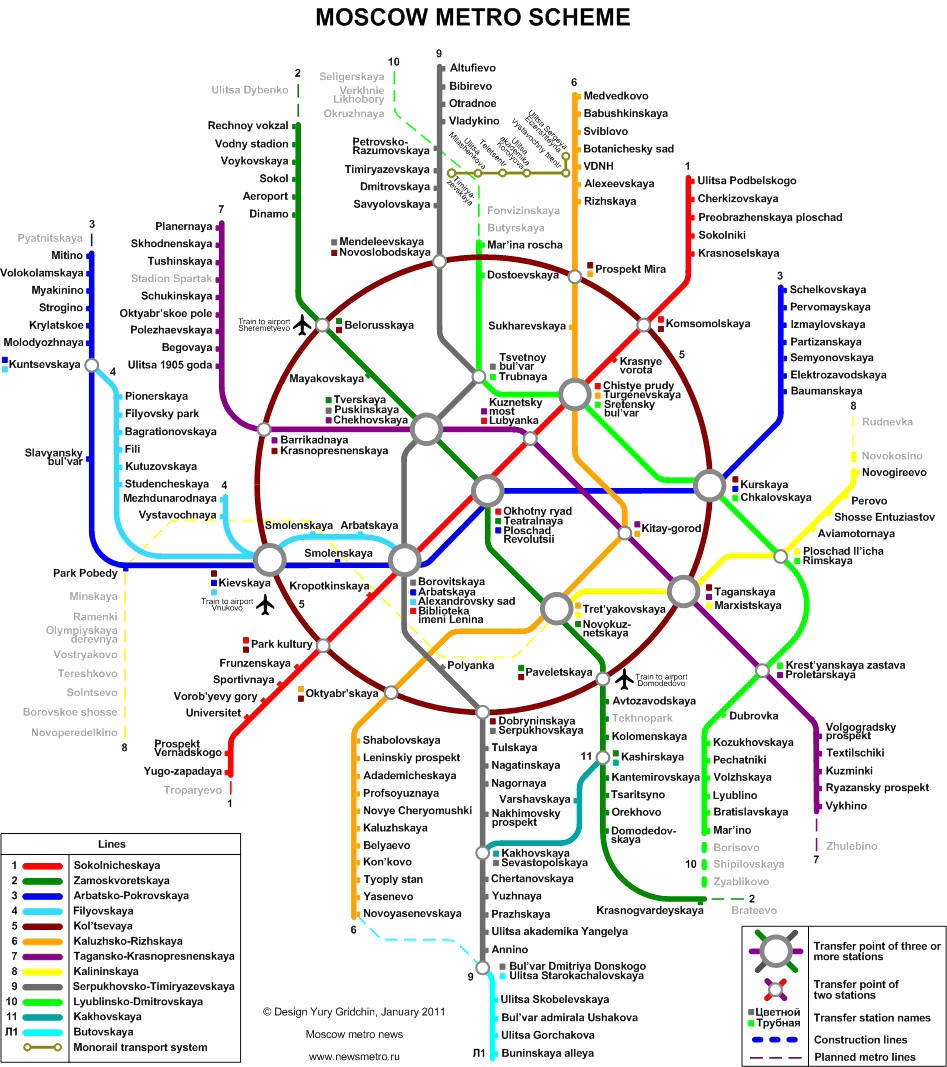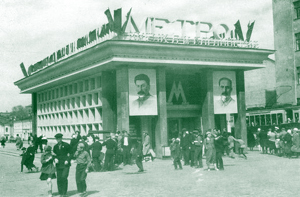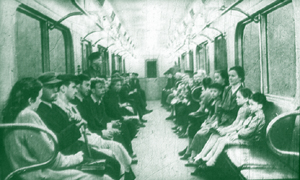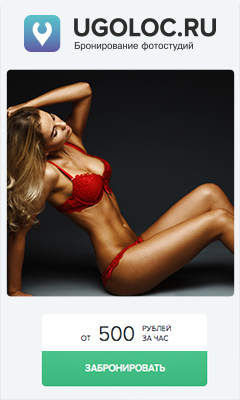|
How to use the Moscow Metro step by step
The web of the 187 3⁄16 miles long underground lines entangles almost all the city.
The old stations have land pavilions. Arbatskaya Station of the Filyovskaya Line.
But the later stations have nothing difference with underpasses, and just the letter "M" distinguishes a station from an ordinary underpass. Domodedovskaya Station of the Zamoskvoretskaya Line
First of all you have to get a ticket at the KACCA ['kα:sə]. You may also get a multi-ride card. Thus each trip would be cheaper.
Metro-ticket (actual size).
Then you should put the ticket to the yellow circle of the right-handed validator, and when the green light the green light display the number of remaining trips, you may go through the automatic gates.
The most of the stations are deeply underground. Therefore the passangers are moved to the platform (the underground part of the station) by the escalators, those can move large numbers of people up and down.
Moscow Metro is the most beautiful subway in the World. The Mayakovskaya Station.
Some central stations are decorated with bronze sculptures. These sculptures in the archway at the Ploshchad Revolyutsii Station depict the people of the Soviet Union.
The pictures of some Russian painters are exposed now in the underground trains.
An old train adjoins to a modern one.
The Rimskaya Station is named after Antient Rome to remind that Mocow is the successor of the Roman Empire (Moscow is Third Rome). After the the Fall of Constantinople to Mehmed II of the Ottoman Empire on 29 May 1453, Ivan III, Grand Duke of Moscow, who had married Sophia Paleologue, a niece of Constantine XI, the last Eastern Roman Emperor, declared: "Two Romes have fallen. The third stands. And there will be no fourth." The station is decorated
with typical Roman columns and a child sculpture
of Romulus and Remus in the far end of the central hall.
People are waiting for the train. The trains arrive every 90 seconds during rush hours.
The Moscow Metro passangers manage to read while standing.
Those, who are not sleeping are reading.
Those, who are not reading are sleeping.
The contemporary passangers read and sleep more than the passengers of the Soviet period. Moscow stray dogs also travel by Metro.
Vykhino is the last station in Moscow to be built above ground, and the last to have side platforms.
|
Moscow rapid transit system (Metro)
|
||||||||||||||||||||||||||||||||||||||||||||||||||||||||||||||||||||||||||||||||||||||||||||||||||||||||||||||||||||||||||||||||||||||||||||||||||||||||||||||||||||||||||||||||||||||||||||||||||||||||||||||||||||||||||||||||||||||||||||||||||||||||||||||||||||||
|
The
first plans for metro system in Moscow date back in the times of
the Russian Empire, but they were postponed by World War I, the
October Revolution and the Russian Civil War. It was not until
June 1931 that the decision to start construction of the Moscow
Metro was taken by the Central Committee of the USSR Communist
Party. The first lines were built under the 1930s Moscow general
plan designed by Lazar Kaganovich, and the Metro was initially (until
1955) named after him ("Metropoliten im. L.M. Kaganovicha").
Advice was given by the London Underground, the world's oldest
metro system (partly because of this connection Gants Hill tube
station, although not completed until much later, is reminiscent
in design of many stations on the Moscow Metro).
Smolenskaya was one of the first station to be opened on May 15, 1935. It was the terminal station of the first stage. Two years later the land pavilion was demolited in the framework of the expansion of Garden Ring.
|
All the magnificence of the most beautiful Metro in the World has been constructed manually by the Red Army sodiers and the Gulag prisoners, including women.
First A-type metro train, 1935
Interior of the Metro trains has almost no changes since 1930s.
|
During the Cold War
The beginning of the Cold War led to the construction of a deep
part of the Arbatsko-Pokrovskaya Line. The stations on this line
are very deep and were planned as shelters in the event of
nuclear war. After finishing the line in 1953, the upper tracks
between Ploshchad Revolyutsii and Kiyevskaya were closed and
later reopened in 1958 as a part of the Filyovskaya Line. In the
further development of the Metro, the term "stages"
was not used any more, although sometimes the stations opened in
1957вЂУ1959 are referred to as the "fifth stage".
During the late 1950s, the architectural extravagance of new
metro stations was significantly toned down, and decorations at
some stations, like VDNKh and Alexeyevskaya, were greatly
simplified compared with original plans. This was done on the
orders of Nikita Khrushchev, who favoured a more spartan
decoration scheme. A typical layout (which quickly became known
as "Sorokonozhka" - "Centipede", which comes
from the fact that early designs had 40 concrete columns in two
rows) was developed for all new stations, and the stations were
built to look almost identical, differing from each other only
in colours of the marble and ceramic tiles. Most of these
stations were built with simplified, cheaper technologies which
were not always quite suitable and resulted in extremely
utilitarian design. For example, walls paved with cheap and
simplistic ceramic tiles proved to be susceptible to vibrations
caused by trains, with some tiles eventually falling off. It was
not always possible to replace the missing tiles with the ones
of the same color, which eventually led to infamous "variegated"
parts of the paving. Not until the mid-1970s was the
architectural extravagance restored, and original designs once
again became popular. However, newer design of "centipede"
stations, with 26 columns with wider ranges between them and
more sophisticated, continued to dominate.
Recent developments
Time evolution of the number of stations.Since the turn of the
century, several projects have been completed, and more are
underway. The first one was the Annino-Butovo extension, which
consisted of extending the Serpukhovsko-Timiryazevskaya Line
from Prazhskaya to Ulitsa Akademika Yangelya (2000), Annino
(2001) and Bulvar Dmitriya Donskogo (2002). Afterwards a new
elevated Butovskaya Light Metro Line was inaugurated in 2003.
Another major project was the reconstruction of the Vorobyovy
Gory station, which initially opened in 1959 was forced to close
in 1983 after the concrete used to build the bridge turned out
to be defective. After many years, the station was rebuilt and
re-opened in 2002.
A more recent major project included building a branch off the
Filyovskaya Line to the Moscow International Business Centre.
This included Delovoy Tsentr (2005) and Mezhdunarodnaya, opened
in 2006.
After many years of building the long-awaited Lyublinskaya Line
extension was inaugurated with Trubnaya in August 2007, with
Sretensky Bulvar in December of that year.
The major Strogino-Mitino extension began with Park Pobedy in
2003. Its first stations, an expanded Kuntsevskaya and Strogino
opened in January 2008, and Slavyansky Bulvar followed them in
September.
Myakinino, Volokolamskaya and Mitino are most recent stations to be opened. They were opened on 26 December 2009.
Current status
The system operates according to an enhanced spoke-hub distribution paradigm, with most rail lines running between central Moscow and its suburbs. The Koltsevaya
(Circular) line forms a circular ring that connects the spokes and facilitates passenger movements between lines without having to travel all the way into the central
city. Each line is identified by an alphanumeric index (usually consisting of just a number), a name, and a colour. The voice announcements refer to lines by name, while in colloquial usage they are mostly referred to by colour, except the Kakhovskaya Line (number 11) which has been assigned shade of green similar to that of the Zamoskvoretskaya Line (number 2), Koltsevaya Line (number 5) and Butovskaya Line (number L1). Most lines run radially through the city, except the Koltsevaya Line (number 5), which is a 20-km-long ring connecting all the radial lines and a few smaller lines outside. On all lines, travellers can determine the direction of the train by the gender of the announcer: on the ring line, a male voice indicates clockwise travel, and a female voice counter-clockwise. On the radial lines, travellers heading toward the centre of Moscow will hear male-voiced announcements, and travellers heading away will hear female-voiced announcements. In addition, there is an abundance of signs showing all the stations that can be reached in a given
direction..jpg)
The system was built almost entirely underground, although some lines (numbers 1, 2 and 4) cross the Moskva River, while line number 1 also crosses the Yauza River by bridge. Fewer than 10% of the stations are at or above the surface level. The surface sections of the Metro include the western part of Filyovskaya Line continuing as Arbatsko-Pokrovskaya Line between Kievskaya and Molodyozhnaya (eight surface stations), and the Butovskaya Light Metro Line (L1) with 4 elevated stations. The other surface stations are Vykhino, Izmaylovskaya and Vorobyovy Gory (the latter is unique in the world being built into a lower level of a bridge). There are several short surface stretches, including those between the stations Avtozavodskaya and Kolomenskaya (where a new station Technopark is going to be built), and between Tekstilshchiki and Volgogradsky
Prospekt.
In the Soviet time, the cost of a single journey was 5 kopecks (1/20 of Soviet ruble). The cost of journeys has been steadily rising since 1991. Inflation caused the price to rise considerably to
26 Russian rubles per trip. Tickets are sold only at manned booths within the stations
named "kassa". In several stations there are tickets vending
machines.
The Metro is open from 5:30AM - 1AM. Stations close at 1AM so your journey must be completed by then (more precisely, at 1AM the last train starts from the end stations, the entrances and transfers between lines are locked and the escalators are stopped - if you caught the
train, you'll be able to exit at any stop on the way, but it might be a long slog up the
steps). Before 7AM and after 9PM, the metro is rarely busy. During rush
hours, trains run roughly every 90 seconds on most lines. At other times during the
day, they run about every two to three and a half minutes, and every six to ten minutes late at
night. As trains are so frequent, there is no timetable available to
passengers.
lines are locked and the escalators are stopped - if you caught the
train, you'll be able to exit at any stop on the way, but it might be a long slog up the
steps). Before 7AM and after 9PM, the metro is rarely busy. During rush
hours, trains run roughly every 90 seconds on most lines. At other times during the
day, they run about every two to three and a half minutes, and every six to ten minutes late at
night. As trains are so frequent, there is no timetable available to
passengers.
Between these times on work days it can be a real squeeze, especially within the
ring. Some escalators are a two minute ride as the stations in the city center are very
deep. On the escalators stand on the right.
It's important to know that colors in the underground's signs don't necessarily correspond to the ones on the maps, so the green line is not necessarily indicated by a green sign (that could be the sign for the gray line). It's less confusing to refer to the numbers, e.g. line 3 is line 3 whatever color is on the sign. There are no English signs inside so have your itinerary ready beforehand or learn to read Cyrillic, which is possible. Anyway, you can use a Russian-English plan while you moving inside a Metro train. Don't let yourself be intimidated by the huge masses of jostling, rushing, cross people. The Russians also take their time to study the tiny signposts to see where to change trains or which exit to take. Don't use the metro if you are claustrophobic as the air is thick especially at rush hour.
Moscow metro fares
|
Ticket type |
Period of validity |
Price |
|
Tickets with limited number of rides: |
||
|
1 ride |
5 days, incl. day of purchase |
28 |
|
2 rides |
56 |
|
|
1 passenger-luggage |
28 |
|
|
1 ride and 1 passenger-luggage |
56 |
|
|
5 rides |
45 days, incl. day of purchase |
135 |
|
10 rides |
265 |
|
|
20 rides |
520 |
|
|
60 rides |
1245 |
|
|
Metro travel card (70 rides) |
calendar month |
1230 |
|
Monthly travelcard for 4 kinds of transport, number of rides in metro being 70 |
calendar month |
2380 |
|
Smart cards with unlimited number of rides: |
||
|
Smart card for students of Moscow universities |
calendar month |
350 |
|
A 30-day smart card |
30 days, incl. day of purchase |
1710 |
|
A 90-day smart card |
90 days, incl. day of purchase |
3485 |
|
A 365-day smart card |
365 days, incl. day of purchase |
11430 |
|
НЕТ
ВХОДА |
NO
ENTRANCE |
|
ПЕРEХОД
НА
КОЛЬЦЕВУЮ
ЛИНИЮ |
TRANSFER
TO CIRCULAR LINE |
|
ВЫХОД
В ГОРОД |
EXIT
TO THE STREET |
|
ПЕРЕХОД
ПРЕКРАЩАЕТСЯ
В 1 ЧАС НОЧИ |
TRANSFER
IS CLOSED AT 1 A.M. |
|
К ПОЕЗДАМ ДО СТАНЦИЙ: |
BOARDING PLATFORMS TO
STATIONS: |
|
ПОСАДКИ НЕТ |
NO
BOARDING |
Beside the underground lines there are two overground branches. First of them is so called Lifht Metro. It is represented by the Butovskaya Line, which essentially continues the Serpukhovsky radius of the Serpukhovsko-Timiryazevskaya Line. For convenience, the first 1.8 kilometres (1 1⁄8 mi) were bored in a tunnel allowing for a convenient transfer with the terminus of the main line, Bulvar Dmitriya Donskogo. For the rest of its length it follows a flyover, guarded by a sound barrier, with both single and dual tracks. Currently, four Light Metro stations, each of identical design, are in operation. The system was opened in December 2003.
The second is a short monorail line, operated by the Moscow Metro company. The line connects station near Timiryazevskaya Metro station and station near tram depot at Sergeya Eyzenshteyna str., close to AREC. The line opened in 2004.
The Lines of Moscow Metro
|
English Name |
Index |
Russian Name |
First Opened |
Latest |
Length, km|mi |
Stations |
|---|---|---|---|---|---|---|
|
Sokolnicheskaya |
|
Сокольническая |
1935 |
1990 |
26.2|16 3⁄8 |
19 |
|
Zamoskvoretskaya |
|
Замоскворецкая |
1938 |
1985 |
36.9|23 1⁄16 |
20 |
|
Arbatsko-Pokrovskaya |
|
Арбатско-Покровская |
1937 |
2009 |
44.3|2711⁄16 |
21 |
|
Filyovskaya |
|
Филёвская |
1958 |
2006 |
14.7|9 3⁄16 |
13 |
|
Koltsevaya (Circular) |
|
Кольцевая |
1950 |
1954 |
19.4|12 1⁄8 |
12 |
|
Kaluzhsko-Rizhskaya |
|
Калужско-Рижская |
1958 |
1990 |
37.6|23 1⁄2 |
24 |
|
Tagansko-Krasnopresnenskaya |
|
Таганско-Краснопресненская |
1966 |
1975 |
35.9|22 7⁄16 |
19 |
|
Kalininskaya |
|
Калининская |
1979 |
1986 |
13.1|8 3⁄16 |
7 |
|
Serpukhovsko-Timiryazevskaya |
|
Серпуховско-Тимирязевская |
1983 |
2002 |
41.5|25 15⁄16 |
25 |
|
Lyublinskaya |
|
Люблинская |
1995 |
2007 |
21.2|13 1⁄4 |
12 |
|
Kakhovskaya |
|
Каховская |
1995 |
1995 |
3.4|2 1⁄8 |
3 |
|
Butovskaya |
|
Бутовская |
2003 |
2003 |
5.5|3 7⁄16 |
5 |
See the map of the Moscow Metro
Each line of the Moscow Metro is identified by a number (with the exception of the Butovskaya Light Metro Line), a name and a color. Most lines run radially through the city, except for the Koltsevaya Line (number 5), which is a ring connecting all the radial lines and a few smaller lines outside. The system was built almost entirely underground, with less than 10 percent of the stations being at or above the surface level.
See also:
![]() Moscow ground public transport (bus, trolleybus, tram)
Moscow ground public transport (bus, trolleybus, tram)
![]() Everything about the Russian capital
Everything about the Russian capital

If you need any help, you can use an emergency column in the centre of the hall.

It is necessary to prepare to exit just after the starting from the previous station. The inscription "Не прислоняться" means "Do not lean".

Having looked at these boards, you can define, where is your train go and where you should change on other line.



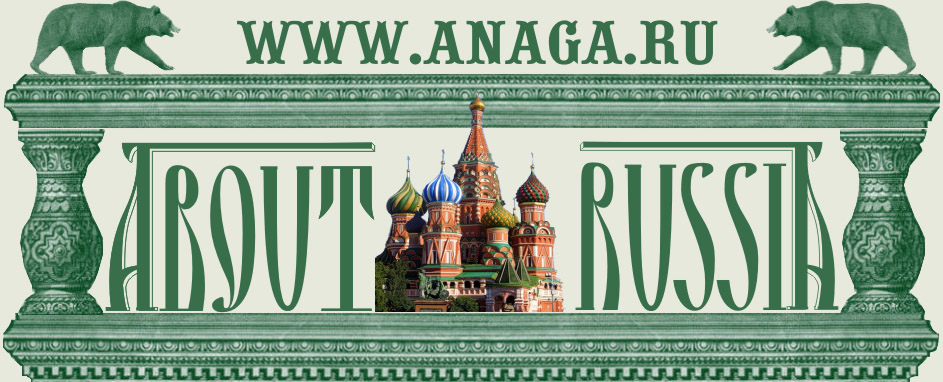

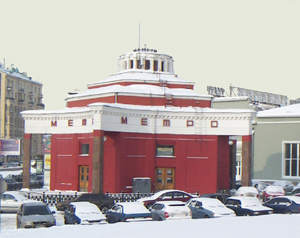





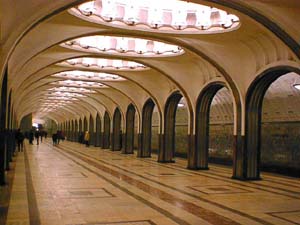

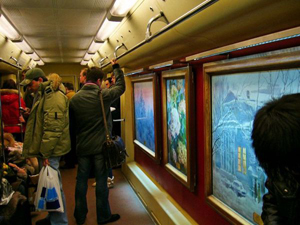
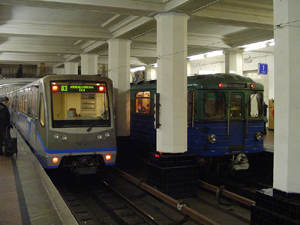



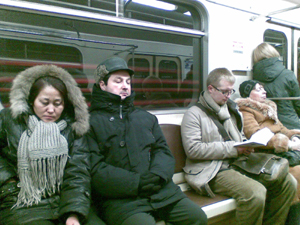


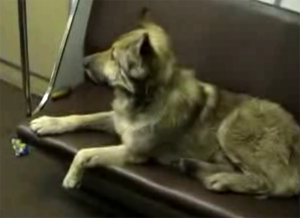
.jpg)
